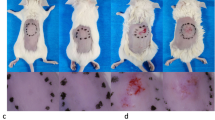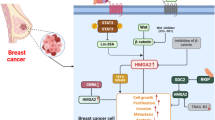Abstract
Acne vulgaris (AV) is a chronic inflammatory disease of the pilosebaceous unit, and Propionibacterium acnes (P. acnes) has been implicated in acne inflammation. Numerous studies have shown that non-coding RNAs play important roles in regulating the pathophysiological processes of acne. In addition, the first imprinted long non-coding RNA (lncRNA) identified, H19, plays a critical role in inflammatory disease. However, the expression and role of H19 in AV remain unclear. In this study, we investigated the effects of H19 in keratinocytes and explored the regulatory mechanisms underlying these effects. H19 was upregulated in keratinocytes treated with P. acnes in a concentration-dependent manner. The phosphorylated forms of the nuclear factor (NF)-κB-related proteins IκBα (p-IκBα) and p65 (p-P65) were significantly upregulated after P. acnes treatment. Additionally, secretion of the proinflammatory cytokines tumor necrosis factor (TNF)-α, interleukin (IL)-6, and IL-8 was upregulated in a concentration-dependent manner. Knockdown of H19 inhibited the expression of p-IκBα and p-P65 as well as the secretion of TNF-α, IL-6, and IL-8 in keratinocytes treated with P. acnes. Moreover, H19 was found to exert its proinflammatory effects by activating NF-κB. H19, which was localized mainly in the cytoplasm of keratinocytes, facilitated Toll-like receptor 2 (TLR2) expression by acting as a miR-196a sponge. H19 thus promoted the activation of NF-κB and the secretion of inflammatory cytokines through the miR-196a/TLR2 axis. These findings provide novel insight into the pathogenesis of AV.







Similar content being viewed by others
References
Dréno, B. Dermatology, venereology, what is new in the pathophysiology of acne, an overview, 31 8–12.
R.A. Bojar, K.T. Holland, Acne and Propionibacterium acnes, 22 0–379.
J.R. Fernández, C. Webb, K. Rouzard, J. Healy, M. Tamura, M. Voronkov, K.L. Huber, J.B. Stock, M. Stock, J.S. Gordon, SIG1459: a novel phytyl-cysteine derived TLR2 modulator with in vitro and clinical anti-acne activity, 27 (2018) 993–999.
A. Qidwai, M. Pandey, S. Pathak, R. Kumar, A.J. Dikshit, The emerging principles for acne biogenesis: a dermatological problem of puberty, 4 7–13.
I.B. Putra, N.K. Jusuf, N.K. Dewi, Practice, the role of digital fluorescence in acne vulgaris: correlation of ultraviolet red fluorescence with the severity of acne vulgaris, 2019 (2019).
G. Tax, E. Urbán, Z. Palotás, R. Puskás, Z. Kónya, T. Bíró, L. Kemény, K.J. Szabó, Propionic acid produced by Propionibacterium acnes strains contributes to their pathogenicity, 96 (2016) 43–49.
T. Zhu, W. Wu, S. Yang, D. Li, D. Sun, L.J.I. He, Polyphyllin I inhibits Propionibacterium acnes-induced inflammation in vitro, 42 (2019) 35–44.
F. Kopp, J.T.J.C. Mendell, Functional classification and experimental dissection of long noncoding RNAs, 172 (2018) 393–407.
R. Zeng, H. Xu, Y. Liu, L. Du, Z. Duan, J. Tong, Y. He, Q. Chen, X. Chen, M.J. Li, miR-146a inhibits biofilm-derived Cutibacterium acnes–induced inflammatory reactions in human keratinocytes, 139 (2019) 2488–2496. e2484.
J. Liang, X. Wu, S. Sun, P. Chen, X. Liang, J. Wang, J. Ruan, S. Zhang, X.J.J Zhang, Venereology, circular RNA expression profile analysis of severe acne by RNA-Seq and bioinformatics, 32 (2018) 1986-1992.
Y. He, H. Xu, C. Li, X. Zhang, P. Zhou, X. Xiao, W. Zhang, Y. Wu, R. Zeng, B.J. Wang, Nicastrin/miR-30a-3p/RAB31 axis regulates keratinocyte differentiation by impairing EGFR signaling in familial acne inversa, 139 (2019) 124–134.
J.X. Pan, LncRNA H19 promotes atherosclerosis by regulating MAPK and NF-kB signaling pathway, 21 (2017) 322–328.
H. Zhu, Z. Chen, Y. Wan, H.J Wang, d. biology, Long non-coding RNA H19 suppression protects the endothelium against hyperglycemic-induced inflammation via inhibiting expression of miR-29b target genes vascular endothelial growth factor A through activation of the protein kinase B/endothelial nitric oxide synthase pathway, 7 (2019) 263.
Y. Hu, S. Li, Y.J. Zou, Knockdown of LncRNA H19 relieves LPS-induced damage by modulating miR-130a in osteoarthritis, 60 (2019) 381–388.
Y. Zhang, J. Yan, C. Li, X. Wang, Y. Dong, X. Shen, X.J. Zhang, LncRNA H19 induced by helicobacter pylori infection promotes gastric cancer cell growth via enhancing NF-κB-induced inflammation, 16 (2019) 1–8.
Z. Liao, J. Zhao, Y.J. Yang, Downregulation of lncRNA H19 inhibits the migration and invasion of melanoma cells by inactivating the NF-κB and PI3K/Akt signaling pathways, 17 (2018) 7313–7318.
Z. Li, X. Shu, Y. Chang, S. Liu, W.J. Wang, Effect of lncRNA H19 on the apoptosis of vascular endothelial cells in arteriosclerosis obliterans via the NF-kappaB pathway, 23 (2019) 4491–4497.
O. Wapinski, H.Y. Chang, Long noncoding RNAs and human disease, 21 (2011) 354–361.
R.-W. Yao, Y. Wang, L.-L. Chen, Cellular functions of long noncoding RNAs, 21 (2019) 542–551.
Zeng, R., H. Xu, Y. Liu, L. Du, Z. Duan, J. Tong, Y. He, Q. Chen, X. Chen, and M. Li. 2019. miR-146a inhibits biofilm-derived Cutibacterium acnes-induced inflammatory reactions in human keratinocytes. The Journal of Investigative Dermatology 139: 2488–2496 e2484.
Y. Han, J. Ma, J. Wang, L.J. Wang, Silencing of H19 inhibits the adipogenesis and inflammation response in ox-LDL-treated Raw264. 7 cells by up-regulating miR-130b, 93 (2018) 107–114.
R. Luo, F. Xiao, P. Wang, Y.-X. Hu, lncRNA H19 sponging miR-93 to regulate inflammation in retinal epithelial cells under hyperglycemia via XBP1s, (2020) 1–11.
Y. Fang, J. Hu, Z. Wang, H. Zong, L. Zhang, R. Zhang, L.J.B. Sun, Pharmacotherapy, LncRNA H19 functions as an Aquaporin 1 competitive endogenous RNA to regulate microRNA-874 expression in LPS sepsis, 105 (2018) 1183–1191.
Y. Tay, F.A. Karreth, P.P. Pandolfi, Aberrant ceRNA activity drives lung cancer, 24 (2014) 259–260.
J.F. Ndisang, Role of heme oxygenase in inflammation, insulin-signalling, diabetes and obesity, 2010 (2010).
T. Olszowski, I. Baranowska-Bosiacka, I. Gutowska, D.J. Chlubek, Pro-inflammatory properties of cadmium, 59 (2012).
P.A. Grange, J. Raingeaud, V. Calvez, N.J. Dupin, Nicotinamide inhibits Propionibacterium acnes-induced IL-8 production in keratinocytes through the NF-κB and MAPK pathways, 56 (2009) 106–112.
B.-r. Zhou, J.-a. Zhang, Q. Zhang, F. Permatasari, Y. Xu, D. Wu, Z.-q. Yin, D.J. Luo, Palmitic acid induces production of proinflammatory cytokines interleukin-6, interleukin-1, and tumor necrosis factor-via a NF-B-dependent mechanism in HaCaT keratinocytes, 2013 (2013).
J.J.D. Kim, Review of the innate immune response in acne vulgaris: activation of Toll-like receptor 2 in acne triggers inflammatory cytokine responses, 211 (2005) 193–198.
J. Kim, M.-T. Ochoa, S.R. Krutzik, O. Takeuchi, S. Uematsu, A.J. Legaspi, H.D. Brightbill, D. Holland, W.J. Cunliffe, S.J. Akira, Activation of Toll-like receptor 2 in acne triggers inflammatory cytokine responses, 169 (2002) 1535–1541.
Kim, J.J. Dermatology, review of the innate immune response in acne vulgaris: activation of Toll-Like receptor 2 in acne triggers inflammatory cytokine responses, 211 193–198.
Y. Ma, Q. Chen, Y. Liu, Q. Wang, Z. Huang, L.J.P. Xiang, P. Therapy, Effects of 5-aminolevulinic acid photodynamic therapy on TLRs in acne lesions and keratinocytes co-cultured with P. acnes, 15 172–181.
L. Coralie, G.P. Alain, O. Guillaume, M. Philippe, D. Nathalie, S. Sophie, C. Stéphane, RJ Anne-Geneviève, One, TLR-2 recognizes Propionibacterium acnes CAMP factor 1 from highly inflammatory strains, 11 e0167237-.
Kowluru, R.A., A. Kowluru, M. Mishra, and B. Kumar. 2015. Oxidative stress and epigenetic modifications in the pathogenesis of diabetic retinopathy. Progress in Retinal and Eye Research 48: 40–61.
I. Nagy, A. Pivarcsi, A. Koreck, M. Szell, E. Urban, L.J. Kemeny, distinct strains of Propionibacterium acnes induce selective human beta-defensin-2 and interleukin-8 expression in human keratinocytes through Toll-like receptors, 124 931–938.
Funding
This work was supported by the National Science Foundation of China (Nos. 81960563 and 81760559).
Author information
Authors and Affiliations
Corresponding author
Ethics declarations
Conflict of Interest
The authors declare that they have no conflicts of interest.
Additional information
Publisher’s Note
Springer Nature remains neutral with regard to jurisdictional claims in published maps and institutional affiliations.
Rights and permissions
About this article
Cite this article
Yang, S., Fang, F., Yu, X. et al. Knockdown of H19 Inhibits the Pathogenesis of Acne Vulgaris by Targeting the miR-196a/TLR2/NF-κB Axis. Inflammation 43, 1936–1947 (2020). https://doi.org/10.1007/s10753-020-01268-z
Published:
Issue Date:
DOI: https://doi.org/10.1007/s10753-020-01268-z




